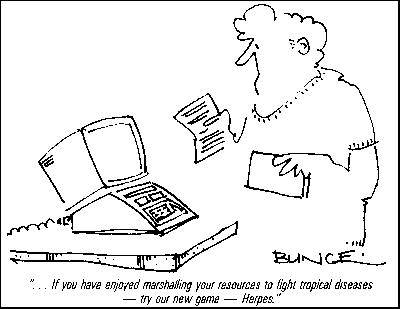As many of you will know, random
numbers on the Spectrum are not truly
random - they may appear to be random, but they are in fact totally
pre- determined. For instance, RANDOMIZE 42 followed by PRINT
RND,RND will always give the same
numbers: 0.049194336 and 0.69065857;
I haven't cheated by using the RANDOMIZE statement, I've just used it to
make the point easier to demonstrate -
RND does not rely on chance.
RANDOM THOUGHTS
Now when you play any sort of game
which involves the throwing of dice or
the tossing of coins, then one would
usually agree that the outcome is truly
random. (At this point, the philosophers amongst us may like to have a
quick debate on the various merits of
free will versus determinism.) Isaac
Newton would tell us that if we knew all
the variables involved (velocity of dice,
density of air, etc) then we could work
out in advance which number would get
thrown; on the other hand,
Schrodinger's Cat tells us differently.
Maybe the world is flat after all.
So now you should be able to see the
subtle difference between the formula
INT (6*RND)+1 and throwing a dice.
However many suitable tests for randomness you may care to think up, one
overriding fact remains - that, whereas
dice-rolling involves the mysterious
hand of fate, the RND formula is completely predetermined. The outcome of
a dice game is fixed before you even
press RUN.
You can add a little bit of chance into
the game by putting a RANDOMIZE
statement into your program somewhere (without a number after
RANDOMIZE). This will confuse the issue
a bit, but it still won't stop the remainder
of the game being just as predetermined
as ever. What you could do instead is to
precede every single use of RND by
either an INPUT statement or a
PAUSE 0 statement, followed by
RANDOMIZE. For instance:
PAUSE 0: RANDOMIZE: LET d=INT (6*RND)+1
This will prevent the game from being
predetermined by relying on the fact
that a human player will not necessarily
|
wait the same number of TV frames before pressing a key; it'll load the random
number seed with a different value each
time and hence give you a different random number each time.
A TRUE DEFINITION
But I'd like introduce you to another
approach. I'm going to define a user-
defined function called FN R(X) (the
number inside the bracket is important).
Here's what happens when it's reached
in the middle of a Basic statement.
Firstly, control will PAUSE until a key
is pressed, and then the computer will
|
select a random integer between one
and the number inside the brackets.
This new random number function is
not predetermined, and as in the above
example, its differing possible outcomes are strictly the result of human
intervention.
Unlike the previous example, however, the determining factor is not how
long you take to press a key - it's which
key you press! In other words - suppose you used FN R(6) to represent
throwing a dice. At this point the action
would PAUSE. The human player
would be aware that the outcome of this
dice throw is determined only by which
of the keys they decide to press, but
does not know, and can never know,
|
| CODE | ASSEMBLER | COMMENTS |
|---|
CD8E02
1C
20FA
| CHANCE CALL KEY_SCAN
INC E
JR NZ,CHANCE
| DE: = immediate keyboard scan.
Waits until your finger is released
from the last key pressed. |
CD8E02
1C
28FA
43
C5
ED4B765C
CD2B2D
C1
EF
A1
0F
| NEW_KEY CALL KEY_SCAN
INC E
JR Z,NEW_KEY
LD B,E
PUSH BC
LD BC,(SEED)
CALL STACK_BC
POP BC
RST 28
STACK 1
ADD
| DE: = immediate keyboard scan.
Waits until a new key is pressed.
B: = code corresponding to the key
pressed.
BC: = random number seed.
Pushes this seed onto the
calculator stack.
B: = key code.
Uses the floating point calculator.
S,1
S+1 |
343716
04
348041
000080
32
02
35F3
A1
03
38
| CH_LOOP STK DATA 75
MULT
STK DATA 65537
MOD
DELETE
DJNZ CH_LOOP
STACK 1
SUBTRACT
END CALC
| S+1,75
75*(S+1)
75*(S+1),65537
75*(S+1) MOD 65537,75*(S+
1) DIV 65537
75*(S+1) MOD 65537
SEED+1
SEED+1,1
SEED
And back to machine code ... |
CDA22D | CALL FP_TO_BC | BC: = new random seed number. |
ED43765C | LD (SEED),BC | Stores this new seed. |
C9 | RET | Returns to Basic. Note that this
final value will be divided by
65536 to give a final random
number. |
|
